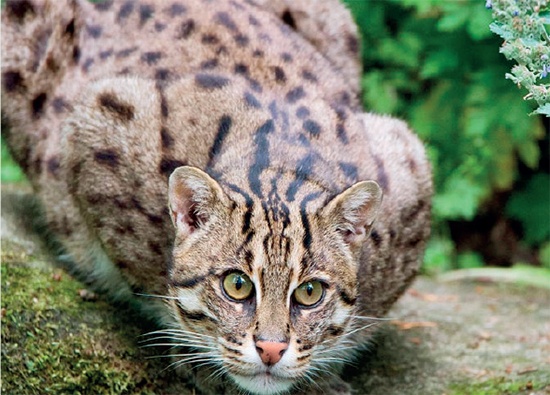News
Fishing cats also targeted by villagers following leopard attack at Panama fearing they are dangerous

by Ifham Nizam
With the killing of a man by a leopard at Panama in Ampara recently, the relatively harmless fishing cats (Prionailurus viverrinus) are being targeted by villagers, who fear the animals as a ‘diviya’ in Sinhala means a leopard.
The Sinhala term for fishing cats is ‘Handun Diviya’, which gives the jitters to many villagers who fear that the animals are akin to leopards and are a threat to them, says researcher cum conservationist Chaminda Jayasekara.
With the human-leopard issue that has emerged with the Panama attack, fishing cats are also being targeted and killed in some parts of the hill country, he says.
“In some parts of Nawalapitiya, children fear to go out when word gets around that ‘Handun Diviyas’ were lurking in the vicinity,” he said.
The killing of fishing cats happen primarily because some people assume that they could harm them as the animals are often misidentified as leopard cubs. This happens especially in the tea plantation areas due to the lack of knowledge on this species, he remarked.
Fishing cats, an elusive feline in the Wetlands, suffer mostly in the dry zone when they sneak into poultry farms or roam in the vicinity. “Poisoning these animals is common especially in areas where poultry farms are located. Poisoning is considered as one of the biggest threats apart from being hit by vehicles in areas such as Sigiriya, when they cross roads to hunt, Jayasekara explained.
This is a big threat to all three small cat species in Sri Lanka, he pointed out.
There is also information that fishing cats are also killed for native treatment of asthmatic patients, he said.
Jayasekara, the Assistant Manager of Jetwing Vil Uyana, further said they built a forest habitat for fishing cats with two lakes on 28 acres. Within last year, seven young cubs were sighted there.
Unlike other cat species, fishing cats prefer an area close to water, he said. “They don’t mingle with domestic cats as jungle cats do. When encountered, they kill domestic cats”.
Of the 40 species of wild cats in the world, four are found in Sri Lanka. Three of them are considered small cats. Apart from the magnificent leopard (Panthera pardus kotiya), Sri Lanka is also home to three of its smaller, but equally threatened, cousins. The fishing cat, jungle cat (Felis chaus) and rusty-spotted cat (Prionailurus rubiginosus) are found in the wetlands and jungles around the island. Their secretive, elusive nature, smaller size and often nocturnal habits make their sightings difficult.
Fishing cats are small to medium sized felines found in countries in South and South East Asia. They have been given a Latin name because of their viverrine or civet like appearance. They are larger than domestic cats and are one of the most elusive small cat species in the world, as well as in Sri Lanka. They are also a threatened species due to habitat destruction.
Unlike other cat species, fishing cats love to be in the water and wetlands and are good swimmers and tree climbers. The size of a fully grown fishing cat is 57 to 85cm in length, with a 25 to 30cm tail. Their weight varies from six to 12 kilograms. The males are slightly bigger than the females. As they are solitary creatures, males and females come together mostly for mating.
Globally, the fishing cat is classified as “Vulnerable” in the IUCN Red List and in Sri Lanka, it is considered “endangered”. They can be found in Sri Lanka, Nepal, India, Bangladesh, Indonesia, Thailand, Myanmar and Cambodia.
They have a stocky and powerful body that is quite long in comparison to their short legs. Their short and coarse coat of fur is olive grey to ashy grey and patterned with solid black spots that run the length of its body and often with black lines along the spine.
Fishing cats typically live near water in thick vegetation. They are not commonly found near fast moving and deep water bodies. This is one of the unique habitat adaptations of fishing cats because, unlike the other wild cat species in the world, they spend most of their life close to the water hunting and are well adapted for an aquatic lifestyle.
They are found in Sri Lanka in habitats like forests, shrubs, grasslands, reed beds, lakes, river, wetlands, paddy fields etc.
Fishing cats are territorial and they live and hunt alone. The size of their territory also varies due to climatic conditions. Especially during the dry season, as most water reserves in the dry zone go dry, they expand their territories for their survival. During the rainy season as they have plenty of food in a small area, they do not expand their territories much. Both females and males overlap their territories.
Mostly within the dry zone of the country, they have suitable habitats and enough food because the dry zone of the country is rich with wetland areas including man-made lakes, canals and paddy fields.
Fishing cats are carnivorous but their main food is fish. They also prey on frogs, snakes, rats and also nocturnal birds like night herons.
They use different techniques to catch fish. They have been observed hunting along the edges of water courses. Once a fish has been spotted, they jump into the water and catch it with their paws. Sometimes they stay in shallow water areas to catch their prey.
When they stay at the edge of the water, they slightly tap the surface of the water by using a paw to imitate a struggling insect to attract fish. When the fish is close enough, they quickly jumps into water and catches it and drags it to the ground, reeds or dense area.
Their gestation period is nearly 70 days and they give birth to one to four kittens at a time. The babies stay with their mother in more dense vegetation areas.
News
Navy act promptly to douse fire on fishing trawler anchored in Galle harbour

The Navy taking prompt action were able to douse a fire that broke out on a fishing trawler at the Galle Fisheries Harbour on 14 Apr 25.
The blaze was first spotted by personnel on board SLNS Prathapa, stationed nearby. Acting swiftly, a diving team from the Southern Naval Command, along with harbour security personnel, rushed to the scene.
Their initial efforts focused on separating the trawler that had caught fire to prevent the flames from spreading. With the situation under partial control, the fire extinguishing system of SLNS Prathapa was activated, successfully dousing the remaining flames, through coordinated efforts of the diving and harbour security personnel.

Latest News
Heat index at ‘Caution level’ at some places in Northern, North-central, North-western, Western, Southern and Eastern provinces and in Rathnapura and Monaragala districts

Warm Weather Advisory
Issued by the Natural Hazards Early Warning Centre of the Department of Meteorology at 3.30 p.m. 16 April 2025, valid for 17 April 2025
The general public are warned that the Heat index, the temperature felt on human body is likely to increase up to ‘Caution level’ at some places in Northern, North-central, North-western, Western, Southern and Eastern provinces and in Rathnapura and Monaragala districts
The Heat Index Forecast is calculated by using relative humidity and maximum temperature and this is the condition that is felt on your body. This is not the forecast of maximum temperature. It is generated by the Department of Meteorology for the next day period and prepared by using global numerical weather prediction model data.
Effect of the heat index on human body is mentioned in the table below and it is prepared on the advice of the Ministry of Health and Indigenous Medical Services.

ACTION REQUIRED
Job sites: Stay hydrated and takes breaks in the shade as often as possible.
Indoors: Check up on the elderly and the sick.
Vehicles: Never leave children unattended.
Outdoors: Limit strenuous outdoor activities, find shade and stay hydrated. Dress: Wear lightweight and white or light-colored clothing.
Note:
In addition, please refer to advisories issued by the Disaster Preparedness & Response Division, Ministry of Health in this regard as well. For further clarifications please contact 011-7446491.
News
Hulftsdorp killing has led to checks on lawyers in some court premises

The government, in consultation with the Judicial Service Commission (JSC) and the Bar Association (BASL), has put in place a system to check lawyers entering selected courts. This follows the killing of Ganemulle Sanjeewa by an underworld hitman, masquerading as a lawyer, in one of the Magistrate Courts at Hulftsdorp, on the morning of 19 February.
Responding to The Island queries in this regard, Justice Minister Harshana Nanayakkara yesterday (16) confirmed the new security arrangement. Minister Nanayakkara, who is also an Attorney-at-Law, declined to elaborate.
Although the police apprehended the suspected assassin, a couple of hours later, the woman, who smuggled in the firearm used in the killing, also masquerading as a lawyer, is still at large.
Newly elected BASL President, Attorney-at-Law Rajeev Amarasuriya, said that scanners had been installed at selected places in line with the security arrangements introduced, following the 19 February shooting in a court. Amarasuriya said so responding to The Island query regarding the post-Hulftsdorp Court complex shooting developments.
The BASL Chief emphasised the pivotal importance of ensuring, what he called, a hassle-free environment for law officers, regardless of security checks necessitated by the latest shooting. Amarasuriya said that security measures should be in place in accordance with threat assessments pertaining to cases taken up at various courts.
The first courtroom killing took place in Nov. 1991 when Sub Inspector Dhammika Amarasena, who had been interdicted over the Wavulkelle massacre, was shot dead while inside the Attanagalle Magistrate court. Amarasena’s father-in-law, who had been seated next to the interdicted policeman, was also killed.
The second courtroom shooting happened in January 2004 when an Army deserter shot dead Dhamamika Amarasinghe inside the Hulftsdorp court complex. Although Dhammika Amarasinghe’s killer gained entry to the court, posing off as a law student, authorities never implemented a comprehensive security plan. However, in the wake of Ganemulle Sanjeewa’s killing, acting IGP Priyantha Weerasooriya, who is also a lawyer, underscored the need to check law officers.
The BASL President said that they were still in the developing stage of the security set up, taking into consideration views expressed by various stakeholders. Referring to Ganemulle Sanjeewa’s assassin carrying a forged BASL identity card, Amarasuriya stressed the need to use technology in counter measures to thwart such practices.
By Shamindra Ferdinando
-

 News6 days ago
News6 days agoSuspect injured in police shooting hospitalised
-

 Features7 days ago
Features7 days agoRobbers and Wreckers
-

 Business7 days ago
Business7 days agoBhathiya Bulumulla – The Man I Knew
-

 Business6 days ago
Business6 days agoSanjiv Hulugalle appointed CEO and General Manager of Cinnamon Life at City of Dreams Sri Lanka
-

 Features5 days ago
Features5 days agoLiberation Day tariffs chaos could cause permanent damage to US economy, amid global tensions
-

 Business5 days ago
Business5 days agoMembers’ Night of the Sri Lanka – Russia Business Council of The Ceylon Chamber of Commerce
-

 Features5 days ago
Features5 days agoMinds and Memories picturing 65 years of Sri Lankan Politics and Society
-

 News6 days ago
News6 days agoLankan security forces Humanitarian Assistance and Relief Team working in Myanmar












